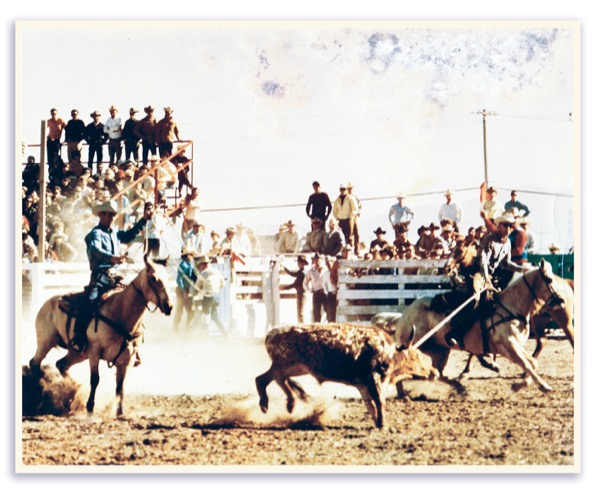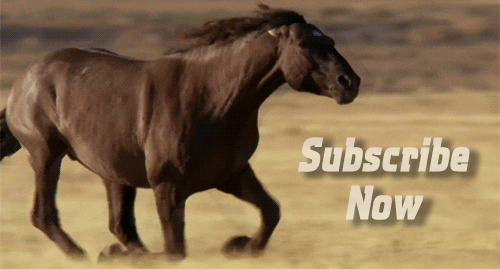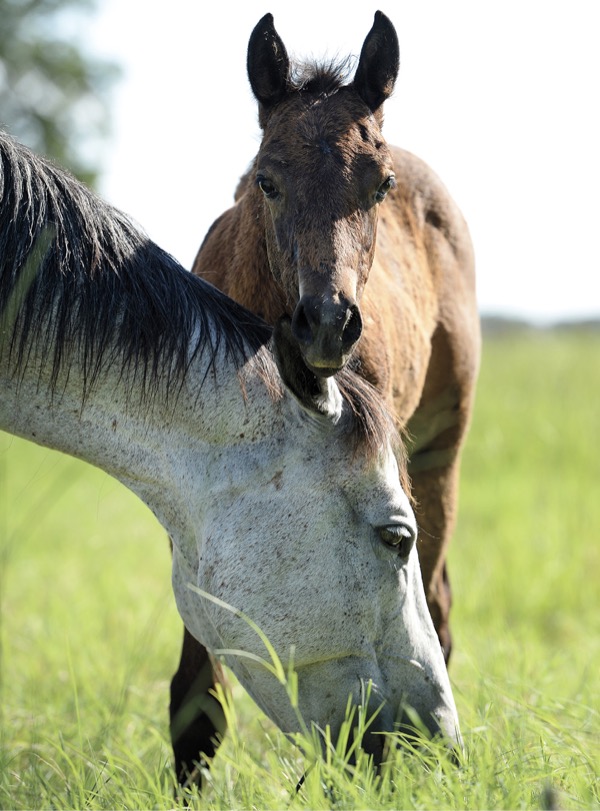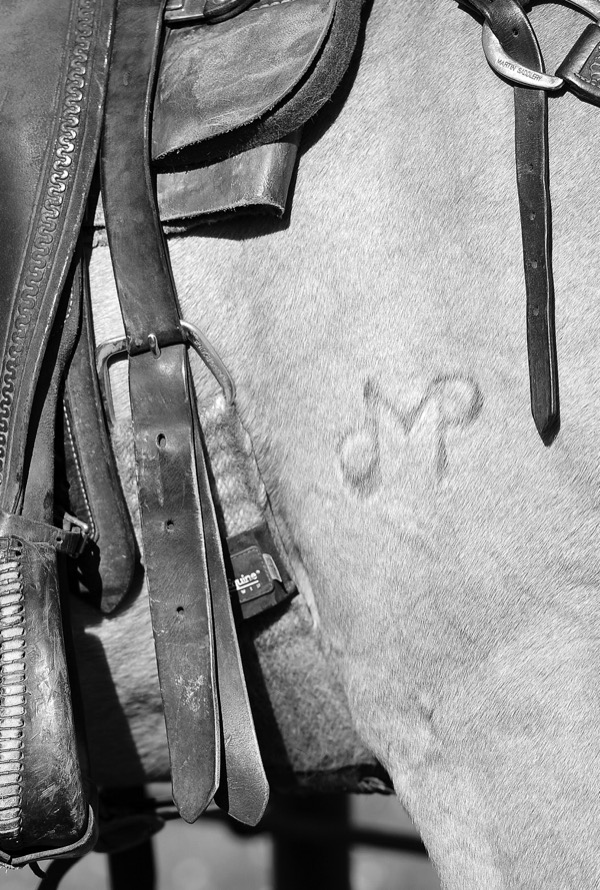A DROP OF DRIFTWOOD
As Potter Ranch perpetuates champion barrel racing, roping and steer wrestling horses, they’re keeping the Driftwood bloodline alive.
By Stacy Pigott
In the early- to mid-1950s, Mel Potter was an eager young cowboy hoping to make it as a roper. As a first-generation horseman, he learned a lot of lessons the hard way. But he also benefitted from the advice and experience of old-timers who saw Mel’s determination and try. When it came to horses, one piece of advice they gave him stood out: “All it takes is one drop of Driftwood blood in a horse to make him a great rodeo horse.”
Mel couldn’t have known it at the time, but those words and that Driftwood blood would serve him well over the years, not only through the horses he rode, but in the breeding program he developed.
Today, Potter Ranch in Marana, Arizona, is known as a leading breeder of rodeo horses, including the Potter Ranch-bred gelding MP Right Back Atya (PC Frenchmans Hayday-Winken Back Atya by Lay A Patch). “Maximus” anchored steer wrestler Todd Suhn’s string of horses as the 2011 AQHA-Professional Rodeo Cowboys Association Reserve Steer Wrestling Horse of the Year. Todd calls him one of the most talented horses he has ever owned.
The same year Maximus was honored by AQHA, Sherry Cervi’s top barrel horse, MP Meter My Hay, aka “Stingray,” tied for the title of AQHA-Women’s Professional Rodeo Association Barrel Horse of the Year. Stingray competed at the National Finals Rodeo in 2003, 2005, 2006 and 2009, when Sherry and the mare won the average, then again in 2010 and 2011. Two years later, they won the NFR average again and also the world championship.
“I think what makes a great barrel racer is a great horse,” Sherry once said in an interview with Cowgirl Magazine. “I would not be where I am in my career without great horses. You can be a good rider and a good competitor and have all the skills, but you have to have that horse to get you to that point.”

LONE WOLF PHOTOGRAPHY
Sherry Cervi, Mel’s daughter, has lit up arenas aboard MP Meter My Hay. “Stingray” is by Mel’s Driftwood-bred PC Frenchmans Hayday and out of Miss Meter Jet by Bar Tonto Jet.
Sherry’s parents – Mel and Wendy Potter – made sure she and her sister, Jo Lynn Alexander, were always mounted on good horses. Today, Mel’s grandkids are winning on similarly well-bred Potter Ranch horses, most of which have Driftwood in their bloodlines.
“What got me interested in the Driftwood horses is back in the days when I was roping pretty good and winning, I’d say 50-60 percent of the guys were riding Driftwood horses,” says Mel, now 83. “But I thought the reason they became great horses was because they had these great ropers riding them.”
But then Mel had the opportunity to ride a few Driftwood horses himself, most notably the legendary Poker Chip Peake, owned by Dale Smith.
“He is, in my estimating, the greatest calf horse that ever lived,” Mel says of “Poker Chip,” the first timed-event horse to enter the ProRodeo Hall of Fame. “He was like having a magic wand on those big calves they roped in some of the big rodeos in those days. A lot of those calves weighed 400 pounds. It was a lot different than it is today.”

COURTESY OF MEL POTTER
Mel Potter and Clifford Whatley competed in team roping, winning quite a bit. Both were often mounted on Driftwood-bred horses.
Roping on Poker Chip was a far cry from Mel’s first horse, Red Ghara, a Red Joe Of Arizona filly he bought as a yearling when he was 12.
“She was the first horse I’d ever broke. I started roping on her and trained her to be a rope horse, so you can imagine what kind of wreck that was,” Mel says with a laugh. “I didn’t know anything and that filly didn’t know anything. That was the first Quarter Horse I owned.”
Against the odds, “Red” turned into a decent enough rope horse and Mel into a handy roper. Mel started competing in junior rodeos and found enough success to keep him hooked, including a couple of top-five finishes at the National High School Finals Rodeo.
As his skills grew, so did his circle of friends on the rodeo circuit. One of them, Bill Bushbaum (brother of multiple champion bareback rider Jack Bushbaum), gave the young Mel some solid advice: If you want to win, get a good horse. He also gave him the name of a horse trainer in Oklahoma who could find a suitable mount.

COURTESY OF MEL POTTER
Mel Potter and PC Frenchmans Hayday, or “Dinero.” The palomino stallion is by Sun Frost, who is out of a daughter of Driftwood Ike.
“He had this horse – he was getting old, and he was actually blind in one eye. I bought him,” Mel says of “Pal,” an unregistered gelding by Oklahoma Star and out of a Bert mare. “That’s when I started being able to rope pretty darn good. He might have been the best horse I’ve ever owned, and I’ve had some real good ones. I was just a young kid and green, but he allowed me to start winning with some of those Rodeo Cowboys Association guys.”
As soon as Mel started winning, he became one of those RCA guys. He was 16.
While he was honing his roping skills in the arena, life was happening, too. Mel finished high school, married his high school sweetheart, Wendy, and enrolled at the University of Arizona, graduating with a degree in animal husbandry.

With his father’s blessing, he put graduate school on hold to rodeo full-time. On paper, it looked like a successful season. He qualified for and competed in the inaugural National Finals Rodeo in 1959. The ledger books told a different story.
“I had a worn-out station wagon, my trailer needed new tires, one of my two rope horses was crippled, and I had only enough money in the bank to enter about the first 10 big winter rodeos,” Mel recalls. “My dad said, ‘Well, what do you think about it now?’ And I said, ‘I think I better go up there to Wisconsin and learn how to grow those cranberries so I can support my habit!’ I guess that was the last time I ever had any illusions of really making a living at rodeoing, but it’s been my hobby and passion forever.”
True to his word, Mel returned home to Wisconsin, where he became the “son” in Potter and Son, one of the largest cranberry suppliers in the Ocean Spray cooperative. To this day, he maintains the schedule his parents started in the 1940s, spending the summer cranberry season in Wisconsin and wintering in Arizona.
Mel continued to immerse himself in the horse industry and decided to breed Red to Speedywood, a son of Driftwood. Dale, Poker Chip’s owner, had also given Mel the opportunity to rope on Speedywood. As with all of the Driftwood horses he rode, Mel was suitably impressed.
“He was a good calf horse, and a good head and heel horse,” Mel says of Speedywood. “I think he was probably the greatest son of Driftwood, producer-wise, but they never bred a lot of mares to him so he didn’t have near the reputation that Driftwood Ike had. They were full brothers. Driftwood Ike had lots of colts, and lots of his colts were great rodeo horses.”
The mating of Speedywood and Red Ghara produced Speedy’s Redwood, the horse that solidified Mel’s belief in the talent and ability of Driftwood horses. Mel started “Charlie” under saddle and began roping on him at age 3. After breaking away a few calves, roping two large steers to get him stopping hard, and roping and tying down seven calves, Mel entered Charlie in the Tucson Quarter Horse Show and promptly won the junior tie-down roping.
As much aptitude as he showed as a rope horse, Charlie also became a top barrel horse for Mel’s then-12-year-old daughter, Jo Lynn. Wendy, a top cowgirl in her own right who qualified for the NFR several times, helped Jo Lynn train Charlie to run barrels. The two often competed against each other – Wendy on her top barrel horse, Auto Dial, and Jo Lynn on Charlie – and it wasn’t unusual for them to finish first and second, with the top spot going to either horse depending on the day.

LONE WOLF PHOTOGRAPHY
Nearly all of the horses he raises have Driftwood in them, Mel says. His logic is simple: “I’m trying to produce horses that win.”
“That’s what sold me on the Driftwood horses,” Mel says of Charlie’s short but impressive career. “They’re natural rope horses. They’re very smart. They learn so quick. You show them one time, and that’s what they do. And they can run. They all stop on their rear ends good, they’re just phenomenal horses.”
Mel’s breeding program was off to a good start with an appreciation for Driftwood horses firmly in place, but it was nearly upended by the untimely death of Charlie at age 6 due to founder. A chance request from a friend breathed second life into Mel’s plans. Drought in northern Arizona had left pastures bare. Did Mel have room in his irrigated fields for a stallion and 20 mares? He did.
“Chuck Sheppard and John Kieckhefer owned Driftwood Ike,” Mel says of the 1962 AQHA reserve high-point steer roping horse. “Chuck sent 20 mares down. All of these mares were either by Driftwood Ike or out of Driftwood Ike mares, and we were splitting the colts. The first year, some of those mares that weren’t by Driftwood Ike were bred to him. I kept those fillies that were daughters of Driftwood Ike, and then a bunch of granddaughters of Driftwood Ike. And that’s kind of how I got started. I ended up with 10-15 darn-well-bred mares.”
In the meantime, Mel was busy with the cranberry business in Wisconsin, where he had also started a cattle grazing operation. Between that, rodeoing and raising a young family, he didn’t really have the time to devote to developing a broodmare band. Not wanting to give up the bloodlines, though, he came up with a solution – he leased out the mares.
The first person he leased the mares to, Bud Tillard, also wanted a Driftwood stud, so Mel sent Lone Drifter.
“Chuck and John had the last crop of colts that came out of Driftwood Ike,” Mel says. “One of them was White Lightning Ike, he went to the Gil family in California, and they kept two of them, Tuffy Ike and Ikes Last. And then he had Lone Drifter, and Lone Drifter had broke a leg when he was young, like a yearling or so. They didn’t put him down, they just casted him and hoped he’d be alright. Well, he got alright, but he had a hind leg that was kind of crooked. I didn’t care; that wouldn’t bother his genetics. So I got Lone Drifter, and I let the Tillard family use him. They gave us some colts by him out of some great mares that they had – not Driftwood-bred mares, but really nice mares.”

lone wolf photography

As a breeder, Mel has registered nearly 600 foals since 1960.
The pattern continued with Pat Cowen in South Dakota and then in Nebraska with Craig Haythorn, who raised two world champion ranch horses out of Mel’s mares.
Recognizing the mares were getting older and Driftwood pedigrees were getting harder to find, Mel brought them home to Marana and started to look for broodmare prospects to buy. He didn’t have to look farther than his own barn for inspiration, as Sherry was starting to make a name for herself in the arena with great horses like Sir Double Delight, aka “Troubles,” and Jet Royal Speed, better known as “Hawk.”
Troubles, who carried Sherry to her first world championship, was by Lay A Patch, so Mel went to Utah and bought several daughters of Lay A Patch. (Coincidentally, he also ended up owning Lay A Patch at the tail end of his breeding career.) Mel’s search for mares related to Hawk turned up one three-quarters sister, Miss Meter Jet, whom he quickly bought. She eventually produced Stingray.
On the stallion side, Mel added to his roster by purchasing PC Frenchmans Hayday, also known as “Dinero,” as a 3-year-old. The palomino stallion is a full brother to Kristie Peterson’s great barrel horse, “Bozo” (French Flash Hawk): The pair are by Sun Frost and out of Caseys Charm by Tiny Circus.
Dinero earned more than $400,000 during a versatile career that included both roping and barrel racing. He was third in the 2005 AQHA-PRCA Heel Horse of the Year voting, the same year he carried Sherry to third in the average at the NFR. Dinero has gone on to produce earners of more than $2.3 million including Hailey Kinsel’s top barrel mare “Sister” (DM Sissy Hayday), who is currently leading the 2018 WPRA barrel standings.
“I was very fortunate buying both of those studs,” Mel says of Lone Drifter and PC Frenchmans Hayday. “Lone Drifter had some great rodeo horses, and Dinero has had some great barrel horses and heel horses. I’d say between Lone Drifter and Dinero, we’ve had 15 horses at the NFR. We now have a stud that is the highest percentage of Driftwood in the world.”
MP Thriftwood, aka “Winston,” is 29.75 percent Driftwood. The 2000 buckskin stallion earned more than $110,000 and was the 2005 PRCA reserve world champion heeler. Alone Drifter (“Lincoln”), a son of Lone Drifter, rounds out Potter Ranch’s stallion string.
“When Winston was 5 years old, Cory Petska won the NFR average on him in team roping,” Mel says. “Out of curiosity, I checked to see the average age of the rest of the horses at the NFR. It was 17. Here Cory comes on this 5-year-old and wins it. That shows you how quickly these horses mature.”
In the Driftwood horses, Mel has found that early maturity coupled with longevity, as evidenced by horses like Maximus and Stingray.
“They’re cast-iron sons of guns. If everybody knew how good the Driftwoods are and how easy they are to train to make a good rope horses, everybody would have them. Those Driftwoods will make you think you’re a horse trainer,” Mel says with a laugh, quoting another saying from rodeo old-timers. “His bloodline almost disappeared because they only left six or seven of his colts studs. They even spayed a lot of the mares because cowboys didn’t want to ride mares, so he didn’t really have a lot of progeny.”
Mel is determined to perpetuate whatever bloodlines are left of the American Quarter Horse Hall of Fame stallion, even if it is just a drop.
“I’ve been very fortunate to have run into those Driftwoods when I did and know how great they were. I’ve rode them and raised them since, and, of course, pretty near all of the horses we have, have some Driftwood in them,” Mel concludes. “I’m trying to produce horses that win. I’m trying to reincarnate Driftwood.”
Stacy Pigott is a special contributor to AQHA Media. She lives in Tucscon, Arizona. To comment on this article, email aqhajrnl@aqha.org.

